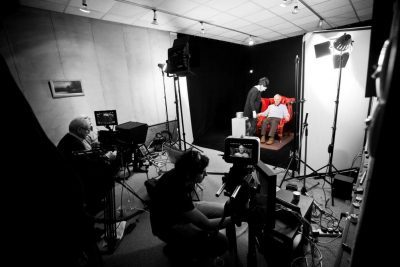Editor’s Note: This article about Holocaust education, written by Mike Enright, originally appeared in UConn Today.
Like members of the Greatest Generation, living Holocaust survivors provide a powerful tool in teaching students about the past.

As the world moves further in time from the horrific events that took place in Europe during World War II, the number of survivors from the Holocaust continues to decline. Like the members of the Greatest Generation, living Holocaust survivors provide a uniquely effective tool in teaching students about the past, creating a challenge for educators as their numbers diminish.
It’s a particularly urgent challenge, as the Holocaust is one of the most common historic events used and cited by politicians, the media, and popular culture as a comparison to contemporary issues. The recent controversy over a Tennessee county school board’s removal of the graphic novel Maus from its eighth-grade curriculum illustrates how potent the Holocaust remains as a political subject, particularly within a school setting.
“When someone feels like their rights are being violated or the government is overstepping their bounds, they’ll cite the Holocaust, which is very dangerous,”
— Associate Professor Alan Marcus
Marcus recently was part of a team that produced a research study that was published in Holocaust Studies that examined the transition of Holocaust education from live to virtual survivor testimony. Marcus also wrote a column for The Conversation on the issue.
“The Holocaust is being trivialized today, and that undercuts the purpose of Holocaust education,” he says. “It’s not the way in which educators or historians want the Holocaust to be used.
“One of the powers of listening to a Holocaust survivor is that they can speak from their personal experiences, and that becomes a very powerful education tool,” he says. “At some point, we are not going to have survivors to speak. World War II is becoming an era of learned memory, as opposed to lived memory. We can learn about it, but we can no longer talk to people who were there.”
This transition has a particularly strong effect on Holocaust education and the effect that live survivor testimony has on students.
“Live testimony of Holocaust survivors bucks the trend in everything we know in education terms,” says Gary Mills, an associate professor of education at the University of Nottingham in the United Kingdom, who was another member of the research team. “Survivors might talk for an hour, an hour and a half, and young people normally get quite fidgety and distracted in a talk that long. There is something about survivor testimony where the students sit and are riveted and silent. It has a major impact on them.”
Marcus and Mills have a history of working on projects together dating back to 2012 when they were connected by colleagues. Marcus coordinates a study abroad program for UConn students at Nottingham, and Mills is an instructor in that program.
Holocaust museums around the United States and the world are trying to address the challenge by creating virtual interviews and presentations as a way to teach future generations of students.
“The power of people is really important, and Holocaust survivors help develop empathy, and empathy is a very important part of Holocaust education,” says Marcus. “As we shift from live survivors to virtual ones, we are going to be missing out on some of that power of people. But we are trying to get what we can capture, and have it stay as a trustworthy source even if the live person isn’t there.”
Holocaust education does need to be based on more than just survivor testimony – whether it be live or virtual.
“If you only study the Holocaust from the perspective of the survivors, you are missing out on a lot of context,” says Marcus. “As I am training teachers, one of the first things I do is talk to them about the different perspectives of the Holocaust. We tend to hear about survivors and victims and also the perpetrators. But, then we talk about the rescuers and the resistors. We explore about eight or nine different roles. There is a lot of curiosity about the perception that survivors didn’t fight back or run away. Survivors really represent a small percent of the people involved in the Holocaust, and are not necessarily representative of everything that happened during these events.”
Holocaust education has been a requirement in British school curriculums since the 1990s. A handful of states in the United States, including Connecticut, make it a required offering in K-12 schools.
“The Holocaust is a unique event that is really morally complex and a good learning opportunity,” says Marcus. “When the Connecticut state legislature voted on requiring Holocaust education, it was unanimous. That hardly ever happens. They heard from a Holocaust survivor and it made a big connection to the events of today. We have an increase in hate crimes and an increase in antisemitic acts. All that data was shared, and that’s what led to the unanimous vote. I think people see the power in the lessons of the Holocaust.”
 Facebook
Facebook
 Twitter
Twitter
 LinkedIn
LinkedIn
